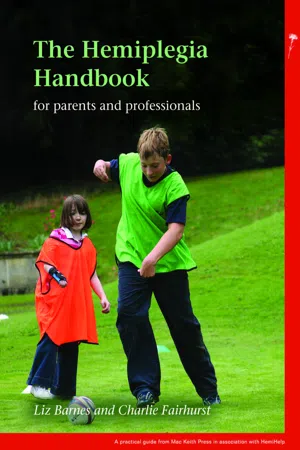
- English
- PDF
- Available on iOS & Android
About this book
Childhood hemiplegia affects up to one child in 1000. It is a condition affecting one side of the body caused by damage to the brain before, during or soon after birth (congenital hemiplegia) or later in childhood (acquired hemiplegia).Until now there has been no book giving an overview of childhood hemiplegia for the people who are most affected by it – the children and young people themselves, and their parents, families, friends and teachers, as well as the professionals working with them on the management of their condition.This highly accessible guide provides this overview, giving the background to how and why hemiplegia happens in children, outlining the different approaches to therapy, and setting out guidance on how to support the child or young adult with hemiplegia. It is practically orientated, answering many of the questions posed by families, carers and members of the interdisciplinary team involved with the children. It is invaluable both for parents and for medical and allied professionals.
Frequently asked questions
- Essential is ideal for learners and professionals who enjoy exploring a wide range of subjects. Access the Essential Library with 800,000+ trusted titles and best-sellers across business, personal growth, and the humanities. Includes unlimited reading time and Standard Read Aloud voice.
- Complete: Perfect for advanced learners and researchers needing full, unrestricted access. Unlock 1.4M+ books across hundreds of subjects, including academic and specialized titles. The Complete Plan also includes advanced features like Premium Read Aloud and Research Assistant.
Please note we cannot support devices running on iOS 13 and Android 7 or earlier. Learn more about using the app.
Information
Table of contents
- Contents
- About the authors
- Foreword
- Chapter 1, Introduction , Liz Barnes
- Chapter 2, Understanding the brain and movement, Charlie Fairhurst
- Chapter 3, Causes of hemiplegia/hemiparesis, Charlie Fairhurst
- Chapter 4, Possible clinical problems:their signs and symptoms, Charlie Fairhurst
- Chapter 5, After diagnosis – what next? Liz Barnes
- Chapter 6, Assessment andclinical management, Charlie Fairhurst
- Chapter 7, Family life, Liz Barnes
- Chapter 8, Education, Liz Barnes
- Chapter 9, Adult life, Liz Barnes
- Chapter 10, The emotional impact ofhaving a child with a disability, Claire Edwards
- Glossary ofmedical terms
- Index